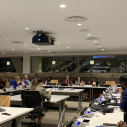
Search
The global MPI explores links between multidimensional poverty and conflict

The 2024 update of the global Multidimensional Poverty Index was published today on 17th October on the International Day for the Eradication of Poverty.
The global MPI offers a multidimensional counterpart to the World Bank’s $2.15 a day measure for extreme poverty and is published annually by OPHI and the the Human Development Report Office of the United Nations Development Programme.
This year’s joint report entitled ‘Poverty amid conflict’ looks at the latest multidimensional poverty data available and focuses on countries that were experiencing various forms of violent conflict, fragility or low peacefulness in the period that their poverty was surveyed to better understand what it means to be multidimensionally poor and live in a conflict setting. The report examines some of the ways in which poverty and conflict intersect and reflects on what this means for poverty reduction. Overall, the findings clearly point to the urgent need for peace.
Key findings
 Of the 1.1 billion poor people, 218 million (19.0 percent) live in war-affected countries. Nearly 40.0 percent of poor people (455 million) live in countries experiencing war, fragility and/or low peacefulness, according to at least one of three widely used definitions.
Of the 1.1 billion poor people, 218 million (19.0 percent) live in war-affected countries. Nearly 40.0 percent of poor people (455 million) live in countries experiencing war, fragility and/or low peacefulness, according to at least one of three widely used definitions.- While national rates vary, overall in countries affected by war (using conflict definitions from Uppsala Conflict Data Program – UCDP), the incidence of poverty is 34.8 percent, much higher than the 10.9 percent in countries not affected by war or minor conflicts. Multidimensional poverty is also more than twice as high in fragile and conflict-affected and low-peacefulness countries.
- On average, the percentage of poor people deprived in each of the 10 global MPI indicators is higher in conflict settings (as defined by UCDP) than in other countries; deprivations in nutrition, electricity, water and sanitation are among the most pronounced among poor people in conflict settings. For example, in non-conflict-affected countries 5.6 percent of the population are poor and lack access to electricity. In war- affected countries this figure jumps to 26.9 percent. Similarly, while 4.4 percent of the population in non- conflict-affected countries are poor and have a child not attending school, the proportion increases to 17.7 percent in war-affected countries.
- Poverty reduction tends to be slowest in the settings most affected by conflict – where poverty is the highest. So, people living in these contexts are being left behind in terms of multidimensional poverty.
- In Afghanistan the incidence of poverty rose by more than 5 percentage points from 2015/2016 to 2022/2023.
- In 2022/2023 nearly two thirds of Afghans were poor (64.9 percent), and almost three of every five poor people were children.
About the global MPI
The global MPI is an internationally comparable measure of acute multidimensional poverty across more than 100 countries in developing regions. Computation of the global MPI begins by constructing a deprivation profile for each household and person in it covering 10 indicators spanning health, education and standard of living. All dimensions are equally weighted, and all indicators are equally weighted within each dimension. A person’s deprivation score is the sum of the weighted deprivations she or he experiences and everyone whose deprivation score is one-third or more is poor by the global MPI. The global MPI is reported nationally and for disaggregated groups, together with the incidence or percentage of the population who are poor, the average intensity of multidimensional poverty, and the share of the population who are poor and deprived in each of the 10 indicators.
The 2024 global Multidimensional Poverty Index (MPI) uses the most recent comparable data available for 112 countries – 21 low-income countries, 87 middle-income countries and 4 high-income countries. These countries are home to 6.3 billion people, about 92 percent of the population in developing regions and 1.1 billion of these are poor. Global MPI values, incidence and intensity of poverty, and component indicators are disaggregated for 1,359 subnational regions as well as by age group, rural-urban area and gender of the household head. In Table 6, we publish harmonised estimates for 86 countries, which provide results for trends over time. Forty have harmonized data for two points in time, 36 countries have trends data for three points in time, six have data for four points in time, three (Ghana, Mexico and Peru) have data for five points in time and Nepal has trends data for six points in time.
Free and open source for use by national governments, development professionals, INGOs, international agencies, academia, journalists and all actors interested in reducing poverty, the global MPI offers a range of useful resources for getting to grips with poverty statistics across the world – including the global MPI 2024 report, extensive data tables, pdf country briefings, computational dofiles, an interactive data bank for maps and charts, and human stories.
More information
- Download the report Global Multidimensional Poverty Index 2024: Poverty amid conflict
- Visit the full set of Global MPI 2024 resources: Data Tables; Country Briefings; Documentation (Methodological Notes); Technical files; Interactive Databank; Multimedia.
- Press release in English
- Press release in Spanish
- Press release in French
- OPHI Update – global MPI 2024
- About the global MPI
- Visit our partner’s webpages – Human Development Report Office, UNDP
Events
- Register online to watch the launch of global MPI 2024 – Bangkok, 4 November (details forthcoming)
- Hybrid OPHI Seminar (jointly hosted with IIEP at George Washington University) on the global MPI – 26 November 2024
Press enquiries
- Oxford: Maya Evans maya.evans@qeh.ox.ac.uk
- New York City: stanislav.saling@undp.org; +1 347 653 1980
















